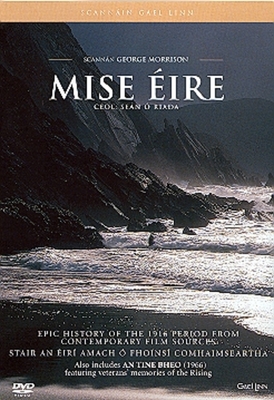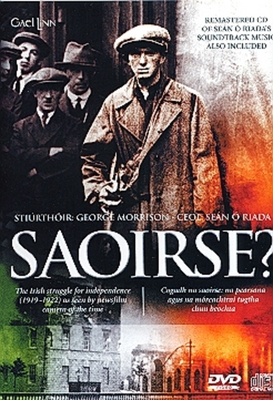Mise Éire/Saoirse? (DVD)
Mise Éire, directed by George Morrison, music by Seán Ó Riorda, Gael Linn, (DVD & CD) (English subtitles) £21.50 + £1.50 p&p
Saoirse?, directed by George Morrison, music by Seán Ó Riorda, Gael Linn, (DVD & CD) (English subtitles) £19.99 + £1.50 p&p


THE ARTISTIC collaboration in the late 1950s and mid-1960s between photographer and film-maker George Morrison and composer Seán Ó Riorda gave birth to two remarkable feature-length historical documentaries, chronicling Ireland's struggle to free itself from British colonial rule in the opening decades of the 20th century.
Recently made available on DVD, courtesy of the Irish language and cultural organisation Gael Linn, Mise Éire (I am Ireland) and Saoirse? (Freedom?) feature a wealth of fascinating photographic and film archive material spanning the period from dying years of the 19th century through to Britain's partition of Ireland, the creation of the Irish Free State and the bloody civil war which followed.
First shown at the Cork Film Festival in September 1959 and put on general release in early 1960, Mise Éire, was ground-breaking on two fronts, being the first full-length film to be released in the Irish language and the first ever to be scored for a full orchestra. The full Mise Éire score, digitally re-mastered from archive tapes, is available for the first time on a separately Gael Linn CD (ORIARDACD03/ £12.99 + £1 p&p)
Painstaking research in Ireland, Britain and France over a number of years gave Morrison access to important historical news footage and photographic images in the making of what was, in essence, a narrative told in montage - held together by Seán Mac Réamoinn historical commentary (narrated by Pádraig Ó Raghallaigh and Liam Budhlaeir) and Ó Riorda's masterfully evocative and stirring musical score.
Morrison's innovative technique, which was almost certainly influenced by Soviet filmmakers such as Sergei Eisenstein, sets out a narrative which sets colonial domination and oppression against growing Irish resistance and a burgeoning national democratic struggle on various fronts.
Images of Queen Victoria's visit to Dublin in 1900, Conservative and Unionist opposition to home rule and the formation of the Ulster Volunteers and British army recruitment efforts in the first world war are set alongside the development of the Irish cultural revival, labour struggles, such as the 1913 Dublin lock out, the creation of the Irish Volunteers and the Irish Citizen Army, the devastation and defeat of the rebel forces in the Easter Rising of 1916, and Sinn Fein's historic victory in the general election of 1918.
Newsreel footage features many of the leaders of the 1916 rising, including Padraig Pearse, Eamon de Valera, James Connolly and Constance Markievicz, as well as film of the fighting and its aftermath.
In addition to the main documentary, the DVD also includes some interesting extra material, including Louis Marcus's 1966 commemorative film, An Tine Bheo. Originally released in 1966 on the 50th anniversary of the 1916 Easter rising, Marcus' short film tells the story of the rising and features the reminiscences of a number of 1916 veterans. An Irish language newsreel, Amharc Éireann, about the making of Mise Éire and its film premiere is also part of the package.
Eleven years after the release of Mise Éire, Morrison took his dialectical approach to Ireland's independence narrative a stage further with a follow-up film, Saoirse?, which dealt with the period from 1919 - 1922.
Like Mise Éire, Saoirse? also featured the music of Ó Riorda. The composer's full score is included here on a separate audio CD.
In both documentaries Morrison makes extensive use of newsreel footage that would have been originally filmed and utilised in support of British colonialism. Through his use of the Irish language he re-enforces his 'translation' of these images from a pro-imperial to an anti-colonial perspective, consciously reclaiming history for the forces of Irish national democracy.
However, while Mise Éire ends on a note of optimism, following Sinn Fein's 1918 election victory, Saoirse? closes on one which is unequivocally tainted with sadness and despair, as the hope of nationhood and independence is dashed on the rocks of the Anglo-Irish Treaty, the confirmation of partition, the split in the national movement and bloody civil war.
The war of independence material is particularly illuminating, not least in illustrating the level and organisation of resistance to British rule, both politically and militarily, and the terror which the British authorities were prepared to unleash in their efforts to quell the Irish revolt. The contrast between the situation in the north-east of Ireland, which was to remain under Unionist rule, and developments throughout the rest of the country is also vividly brought home. The dark years of discrimination against the nationalist population of the north was about to begin in earnest.
While the Treaty signed by Collins and the other Irish plenipotentiaries heralds the start of the revolutionary movement turning in on itself - with the Free State forces availing themselves of a plentiful supply of British munitions in their effort to stem the tide of republican opposition to the Treaty - the newsreel footage of these, and other, momentous events is never less than fascinating.
By the time the viewer reaches the end of Morrison's film, the reasoning behind his apparently enigmatic use of a question mark in the film's title becomes clear. Freedom constrained and at what price? The narrator provides an answer: "Thus is the city's heart broken - the nation's heart: thus companions part. A battle ends and a war begins - the torment of civil war. Bitter indeed is the ending of our story."
Although the struggle for peace and unity has entered a new phase in recent years, eight-and-half decades later the story is not yet over. In the meantime, we must thank Gael Linn for making these valuable historic documentaries available to a wider audience.
Mise Éire and Saoirse? are available from Copperplate Mail Order, 68, Belleville Rd, London SW11 6PP; tel/fax 0207 585 0357
Connolly Association, c/o RMT, Unity House, 39 Chalton Street, London, NW1 1JD
Copyright © 2007 David Granville

